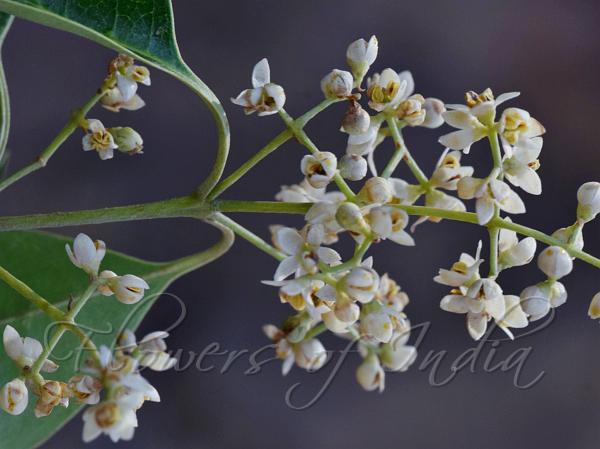|
| Native Olive |
|

|

| File size | 541291 |
| Original date | 4/24/22 7:19 PM |
| Resolution | x |
| Flash | Flash did not fire |
| Focal length | 90.0mm |
| Exposure time | 1/200s |
| Aperture | 18.0 |
| Focus Distance | |
| Metering Mode | $meteringMode |
| Camera make | NIKON CORPORATION |
| Camera model | NIKON D5300 |
| Sensor type |
|
|
|
|
Photo: |
Botanical name: Olea paniculata Family: Oleaceae (Jasmine family)
Synonyms: Olea bournei, Olea glandulifera, Olea glandulosa
Synonyms: Olea bournei, Olea glandulifera, Olea glandulosa
Native Olive is a tree 5-15 m tall, bark 1 cm,
greyish-brown, peeling in brittle scales; blaze dull yellow. Leaves are
simple, opposite; leaf-stalk 1.0-3.5 cm, slender, hairless, grooved
above; blade 7-13 x 2.5-5 cm, elliptic, elliptic-obovate or elliptic
lanceshaped, base narrowed, tip tapering, margin entire, hairless,
papery; lateral nerves 4-7 pairs, hairless, pinnate, prominent;
intercostae netveined; domatia present. Flowers are bisexual, creamy, 4
mm across, borne branch-end or lateral compound, cymes. Flowers are
deeply lobed; petals 4, spreading, 2 mm long, tube 1 mm long; stamens
2, protruding; anther oblong Sepal-cup is 1 mm, hairless, sepals
triangular, gland-dotted. Fruit is a drupe, 1.5 x 0.8 cm, ovoid,
brownish-black; seed one. Native Olive is found in moist ravines, open
valleys, at altitudes of 1200-2400 m, in the Himalayas, Yunnan, India,
Indonesia, Malaysia, Nepal, New Guinea, Pakistan, Sri Lanka; Australia.
Flowering: April-May.
| Identification credit: Ashutosh Sharma | Photographed in Solan district, Himachal Pradesh. |
• Is this flower misidentified? If yes,